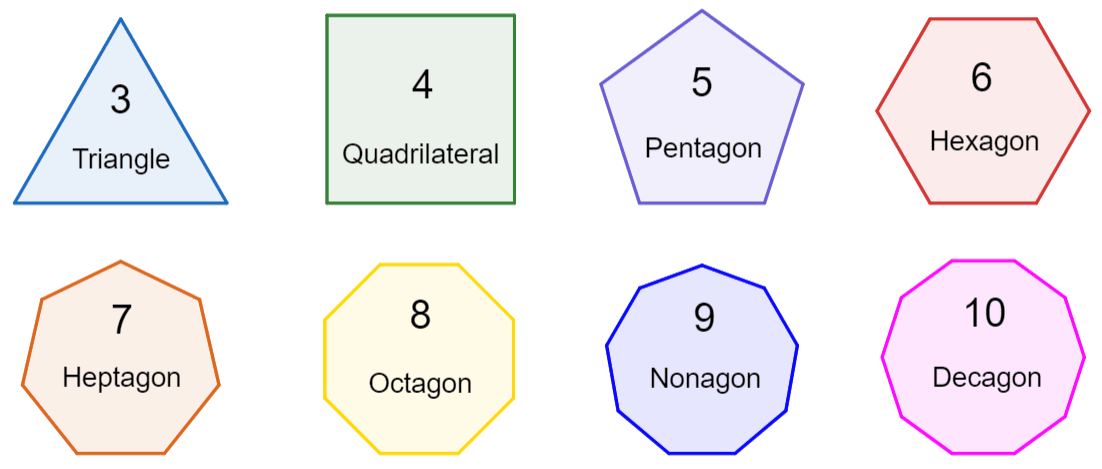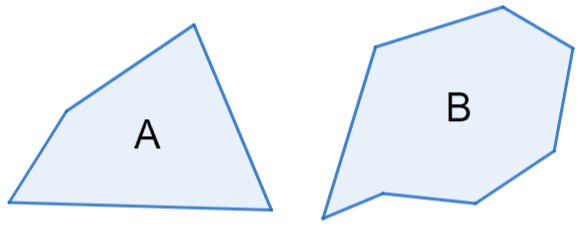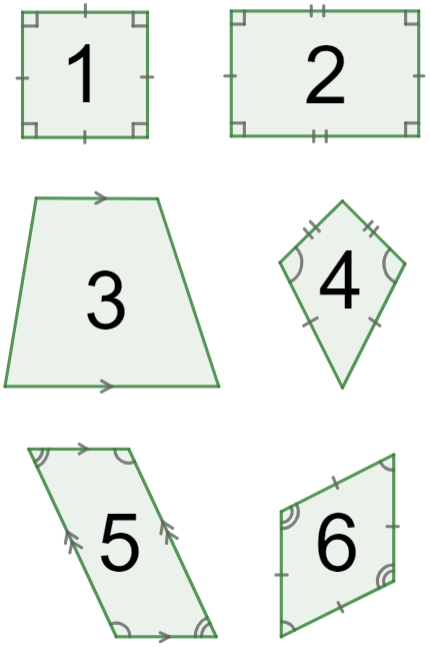This page contains the GCSE AQA Mathematics 2-dimensional shapes Questions and their answers for revision and understanding 2-dimensional.
You will already be familiar with the names of some shapes, but it’s important to recognise the names of up to 10-sided shapes, as seen below.

All of these shapes are regular, meaning that all of their sides are the same length, but even if the shapes are irregular then the names stay the same – a 6-sided shape with sides of different lengths is still called a hexagon.
Example: Write down the names given to shapes A and B.
Counting the number of sides, we see that shape A has 4 sides, therefore it is a quadrilateral.
Doing the same for B, we see that it has 7 sides, and therefore it is a heptagon.

Triangles and quadrilaterals are the shapes we will see most often. As a result, we have names for specific types of them. The different types of quadrilaterals you should be familiar with are:

1. Square – Has 4 sides equal in length, and 4 equal angles (all 90°).
2. Rectangle – Has 4 equal angles (90°), and its opposite sides are equal in length.
3. Trapezium – Has one pair of parallel sides, and those sides must be opposite to each other.
4. Kite – Has two pairs of equal sides, and each pair must be adjacent to each other. Additionally, two of its angles (as marked on the picture) are equal.
5. Parallelogram – Has two pairs of parallel sides, and each pair must be opposite to each other. Additionally, opposite angles are equal and adjacent angles add to 180°.
6. Rhombus – Has 4 sides equal in length. Additionally, opposite angles are equal, and opposite sides are parallel.
The different types of triangles you should be familiar with are:

1. Equilateral – Has 3 sides equal in length, and all 3 angles are 60degree60°.
2. Isosceles – Has 2 sides equal in length, and the two base angles (see: the picture) are equal.
3. Right-angled – Has 1 angle equal to 90degree90°.
4. Scalene – Has 3 sides of different lengths, and no angles are the same.
Nets
Nets are what you get if you can unfold a 3D shape along its edges to form a 2D shape. In order to understand nets properly (and eventually be able to visualise how they fold/unfold in your head) it can be useful to print out the nets of various shapes and having a go at folding them into the correct shape. In the following example, you can try this method – or simply the draw the nets on your paper if you don’t have access to a printer – if you’re not sure.
Example: Which one of the following nets does not form a cube?

The first important thing to recognise is that all of these nets are made up of 6 squares, meaning they all match the number of faces on a cube.
When folding nets (either literally or mentally), it helps to choose 1 face to be the base and then fold the net around it. Often the folding is easier if you choose a face that is connected to lots of other faces.
In the case of net A, you might choose the square in the middle of the cross, and then you will see that the 4 squares adjacent to it form the sides of the cube, whilst the furthest left square becomes the top face. Note: the folding will always work regardless of which base you choose.
For net B, we might choose either of the corner faces to be our base. In any case, in folding the net we will see that it does form a cube.
For net C, it might make sense to pick the one face that is connected to 3 other faces as our base. However, we will see that when we fold it, we end up with two squares overlapping, and one square left empty. There’s no way to fold C that will result in a cube, so our answer is net C.
We now know net D must form a cube, so you should pick a square to be your base and have a go at folding it yourself.
